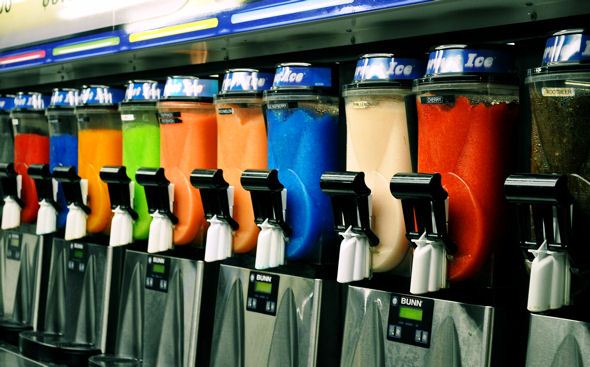
Do you know the differences between smoothie and smoothie, granita or frappe? If you do not know exactly what each of these drinks consists of, do not worry. Coming up next, we tell you. This reminds us of the game of the 7 differences, we all know they are there, but it is not always easy to recognize them. That’s why we wanted to tell you in this post what are the differences between smoothie and smoothie mainly, but without forgetting either the slush or the frappe. Let’s go there! Remember that you can throw everything in the slush machine for hire you can find today at Snow Flow.
All of them are delicious drinks that make us crazy with their flavours, colours and textures, but … what differences are there between them?
Milkshake
The milkshake is a drink made with milk or ice cream and can carry fruit, yogurt, chocolate, etc. This mixture is usually made with a blender, hence its name, although today there are already machines to create your own shakes.
According to the country, the milkshake is called one way or another, as meringue or milkshake (in some cases malted milk is added). In general, the smoothie is usually a much more solid drink, with more body than the rest, except for the smoothie. Let’s go with him!
Smoothie
The smoothie is a fruit smoothie that began to be marketed under this term that comes from English, smooth = smooth.
It is prepared based on pieces of fruit and like the shake is usually creamy and consistent. The authentic smoothie must be prepared based on a mixture of fresh or frozen fruits, crushed or liquefied at the time of its preparation.
Slushy
And finally, there would be the frappé, originally from Greece and that could be included in our list of types of coffee. Originally it was a coffee with ice covered in foam or cream. With its internationalization and growing popularity, other variants have appeared in which it is prepared with chocolate, coconut or vanilla, among others.
What drinks are served cold?
Ice is often used to serve certain beverages that, although served in their natural or hot state, sometimes need to be cooled, although the temperature varies from one to the other. Sparkling wines (such as champagne and cavas) or cider should be cooled well before serving using buckets with ice cubes and water.
Still wines are also cooled before serving them. Reds, for example, should be served at a temperature of 14-20 ° C, so in warmer countries they should be cooled in buckets with ice and water. The aperitif wines, such as vermouth, sherry, manzanillas, dubonnet and others, are cooled before serving them.
The same happens with sweet wines of “body”, such as vines, malaga, muscatel, malvasia, ports, which although served at room temperature in countries that are not warm, in climates of high temperatures it is required to cool them.
The creams, liqueurs and spirits are served at room temperature, but can also be made on rocks or with frappé ice according to the client’s taste.
For cocktails
One of the most widespread uses of ice in bars is the service of drinks in “high ball”, which is usually done in 8 ounce glasses, in which you put ice, an ounce of drink or 45 mL (ounce and media) and a soft drink next to it.
If the “jaibol” was an appetizer wine, which happens with some frequency, serve two ounces of this. The “frappé” drinks are served in the low cocktail glass (3 ½ ounces), filled with shaved ice, where an ounce of drink is poured. For drinks “on the rocks” a glass of 6 to 8 ounces (old fashion) is used where 3 or 4 pieces of ice are placed and on these 1 ½ ounces of drink.
In the case that it is an aperitif or sweet drink “on the rocks”, 3 ounces of these should be served. In the case of cocktails, there is no definite rule for the use of ice, as this will depend on the formula of each one. However, it is essential that it is always clean and transparent, and as little manipulated as possible.
If making a cocktail exceeds any amount, it cannot be used for making another, but thrown away.
When the bartenders say that “ice is the last thing in the mix” they refer to the cocktails made in mixing or composition glass (stirred), in the shaker (handshakes), in the blender (frappes), in their own container (refreshing, long), as well as atypical or fantasy.
Likewise, ice can be used to temper, that is to say, to previously cool glasses, glasses, shaker and glass to mix before adding a cocktail, in which case it is always discarded. In the case of hand-stirred and hand-stirred cocktails, they should be squeezed before serving in the previously tempered cup or glass.
Some consequences for ice machines
Although ice machines are already quite common in bars, they require special treatments to guarantee the quality of their product, specifically the purifiers, which are activated with common salt and left to rest for six to eight hours, after which is drained until the water comes out without salt, to obtain an ice with brilliance and transparency.
They should also be cleaned with a certain frequency with special descaling products, which are allowed to recirculate for two hours mixed with water through all the ducts and the pump to eliminate all the accumulated magnesia. After this process the machine is thoroughly rinsed, put into operation and it is recommended to discard the first ice manufacture.
Here at Snow Flow you will find slush machines for home you can buy or rent and make sure your guests can enjoy a refreshing option specially during summer days. Contact us today if you want more information about our machines and how much of a good addition for your party they would be. We’ll be happy to help you.